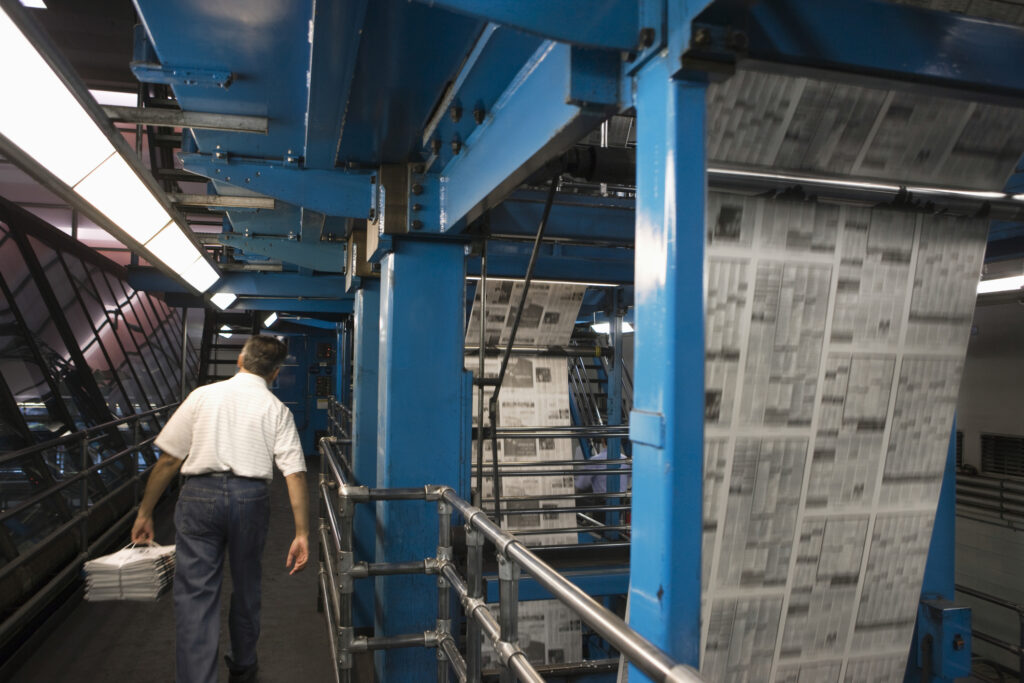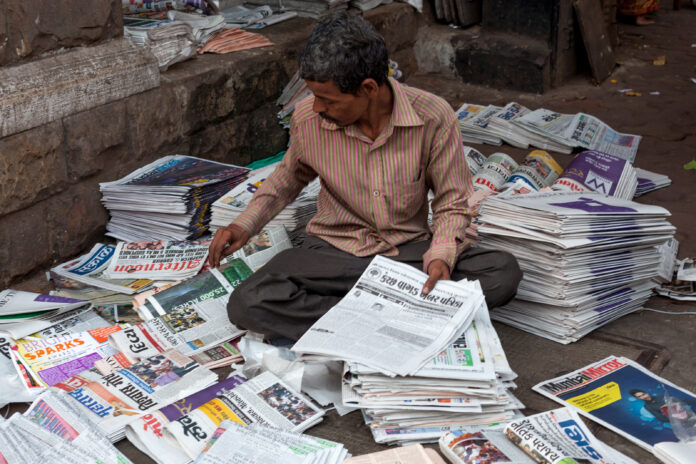In the 1970s, when one visited a large metropolitan newspaper’s printing plant in India, it typically ran a Goss or Wifag double-width or a Polygraph single-width letterpress rotary machine for three or four hours at night to print black-and-white dailies. The press was cleaned and polished during the day with the occasional supplements or insert sections.
Looking back, the process seems complicated. Hot lead column-wide type was cast on Linotype machines with the galleys assembled in pages in a chase. The assembled page in the chase was pressed into an imported paper mache sheet called a flong, which was used to cast the semi-circular lead plates called stereos for mounting on the press. The only imported consumable was the flong – the type and plates were melted again and again for reuse every day and night. Incidentally, none of the workspaces were air-conditioned in those days.
In the second half of the seventies, the newspaper offset presses, especially those manufactured in the country by several producers, proliferated together with the spread of computer-aided photo typesetters – first using spinning discs and rectangular grids that contained the characters to be flash exposed on film galleys (columns) assembled by hand into pages, which were then exposed in a vacuum frame on to deep-etch offset plates. These aluminum plates had to be replaced with a new set or baked for longer runs.
This process worked for most dailies but the bigger ones couldn’t throw away their imported behemoths and for a transitional migration to offset; they used polymer letterpress plates that could be exposed from film pages assembled from phototypeset galleys. Gradually, these presses were retired and the large dailies invested in double-circumference and double-width offset presses or sometimes in a series of single-width offset presses. Color pages in newspapers were catching on and apart from using the local Y-towers, some dailies imported single-width presses with autopasters and 4-color satellite towers.
Cathode Ray Tube (CRT) phototypesetters did away with the need to store-type characters on discs as storage technologies evolved and Random Access Memory (RAM) became cheaper. In 1984, Adobe came up with PostScript, an efficient language that resembled Pascal and C for storing the shapes of characters as an outline, which could be completed with a fill command. PostScript enabled the efficient and economical design of non-Roman scripts such as those required for the Indian languages. It also enabled scanned images to be color-separated and half-toned within a PostScript page. Laser typesetters enabled the incorporation of halftones and text in film pages.
Adobe’s Portable Document Format (PDF) allowed the digital portability of pages that could be sent for film exposure to remote printing plants, and later in the 1990s to expose offset plates without the need for any intermediary image carrier on computer-to-plate devices called CtPs. These overlapping waves of change, enabled by the ease of offset printing and successive developments in computer-aided typesetting and prepress, led to the proliferation of more color pages and editions each night – in some dailies, a page or two was changed for every district in the state.
Economic growth powers significant growth of language newspapers
With the government’s economic liberalization in 1991, print advertising flourished, and Indian newspapers greatly increased their color pages and expanded their geographic spread. Many built plants in several cities over the next three decades. Several larger language papers built a printing plant every few hundred kilometers – sometimes in small towns just across the road from their competitors.
These were enabled largely by the easy digital transmission of PDF pages using the fast-growing cellphone and Internet infrastructure. The locally manufactured web offset printing machines grew to five and six towers, including 4-Hi towers able to produce 24 broadsheet pages in a single run, often with 12 or 16 pages in color. More ambitious installations had presses for printing all 24 pages in full color.

Simultaneously, in the three decades from 1990 to 2020, the big metropolitan multi-location news media groups with dailies in several languages invested in imported newspaper presses. They first installed double-width double-circumference and then double-width single-circumference presses with significant automation. Newspaper growth in parallel with the high growth of literacy and the economy continued till roughly 2015 or perhaps another couple of years, although new media channels and ecosystems took away some of their advertising.
While the news media ecosystem from 1980 to 1990 consisted almost entirely of print, the government then allowed private television channels to broadcast news. As these proliferated, often they were owned by the newspaper groups – as cross-media channel ownership was and is allowed by the government. However, when the government allowed the news media groups to own radio stations, they were forbidden from broadcasting news – this remains the monopoly of the government-owned All India Radio.
From the 1990s onward, private television entertainment and news channels gained advertising share, although many of the 500 news channels in more than 20 Indian languages have rarely been very profitable. Nevertheless, they are seen as essential for their political influence and were sometimes seen by newspaper groups as an add-on or an obvious extension. Television has its dynamic, and many of the print news media’s loss-making adventures in ‘electronic media’ closed down.
In the mid-1990s, India’s economy began its high growth path with information technology services exports, private education, and healthcare growing; modern automobiles were manufactured in the country, and the first mass transportation systems such as the Delhi Metro took off. Cell phones arrived together with the Internet and with these, the country spread its digital backbone and infrastructure.
From 2000, the newspaper industry was largely able to withstand the growth of private television and radio as the advertising pie grew significantly. However, while the widespread use of the internet and smartphones compelled newspapers to invest in websites and digital news, it was not able to monetize these channels. Its main revenues have always come from print advertising.
The situation in 2025
In the past 25 years, the Indian news print media industry has continuously lost significant market share to big tech such as Google and Facebook even as it recorded its highest revenues in 2018. Then came the Covid-19 pandemic, which wiped out the heart of the Indian newspaper industry – its distribution system driven by the early morning last-mile bicycle and motorcycle deliverymen.
Since the end of the pandemic in 2021, the Indian newspaper industry has kept recovering in circulation and revenues. Some of this is based on reducing resources but it is largely based on reducing costs by reducing editions, pagination, and circulation. It has benefitted from the benign prices of newsprint and from increasing per-copy prices and circulation revenues. Giveaway copies have been reduced or eliminated. Ad rates have been maintained at nearly pre-pandemic levels while circulations are decreased to ‘Sweet Spot Calculations’ that optimize the minimum number of copies needed to keep advertisers on board. The wave of expensive top management professionals from FMCG companies has abated with many being replaced by more down-to-earth talent.
However, the industry is still in trouble – at roughly half of its previous combined daily circulation of 115 to 125 million copies each morning in former days. Our most recent estimate puts it well below even 80 million copies, with some experts indicating harsher and lower numbers for the big dailies. Industry leaders and experts do not expect a full recovery of circulation to previous highs despite the continuous increases in population, wealth, and literacy.
Mistakes in strategy and execution
The news media industry, which is an abundant supplier of news to big tech, has mistakenly relied on the government to negotiate with big tech for a fair share of digital revenues. This endless process continues to date and has only led to the government flexing its muscles with new digital laws. Unlike in Europe, Canada, Latin America, and notably in Australia, the government does not seem to be too keen to compel big tech to share its revenues with the Indian news media industry on any systematic or equitable basis.
Secondly, at a time of what newspapers perhaps see as political compulsions, they have (with notable exceptions), become overly dependent on government and election advertising. This has made them even less credible and palatable to younger audiences brought up on an information diet of smartphones and video news channels, often produced by journalists, who have been expelled by mainstream news channels.
Alternative web and video channels on YouTube have proliferated, many with millions of subscribers and advertising from leading FMCG companies. Alternative news websites that are video-friendly have also excelled in providing the news, opinion, and entertainment that traditional print media companies cannot provide to their targeted constituencies. Some do not consider themselves as ‘alternative’ anymore but as mainstream media.
A leading newspaper owner at an industry conference last year called this the “creator economy.” It is this creator economy that now drives the increasing share, if not the bulk of the growing digital revenue share of the Indian advertising pie. Even as the creators get a small share from Google’s YouTube, their costs are lower and their news gathering and production efficiencies are higher than the traditional news media using paper, ink, and physical distribution. Indeed, to get the eyeballs of the younger demographic or simply those who cannot find obvious news content in their pages, some leading newspaper-owned video channels produce cut-and-paste clips with subtitles of news that they are reluctant to carry in their ‘balanced’ pages.
We have described the crisis or multiple crises of the Indian newspaper industry in the previous articles of this series – broadly, the loss of the younger demographic with circulations never to return to previous highs; loss of advertising share to digital even as television news is also losing advertising share to the creator economy. The shortage of production personnel ready to work in newspaper plants; and, the obsolescence and high depreciation of big imported newspaper presses and mailroom systems where genuine spare parts are either impossible to get or very expensive to procure or manufacture.
What are the remedies, if any? Diversification, yes – several newspapers’ inheritors have invested in new unrelated businesses such as real estate, event management, fast food, and printing-related businesses such as packaging. Even innovative and authentic multichannel news publishers who multiplied their print revenues in the previous 45 years have warned their next-generation shareholders to expect lower revenues from businesses built over many decades, and sometimes over a century.
Ironically, India is a country that still has headroom for print – its diverse population is hungry for authentic news – each day its citizens discuss the lies spread by the mainstream media that nevertheless cites studies and smugly considers itself the most reliable news source. Perhaps this is true in comparison to the more irresponsible and slipshod electronic media, but overall, the print media with some notable exceptions, has shot itself in the foot by its lack of authenticity and evidence-based news. As one newspaper owner said many years ago – “The need is for news and images that are worth paying for.”
Secondly, there is a gross underestimate of the diversity and intelligence of the population that is literate, aspiring, economically, and socially engaged. I paraphrase from memory what Robin Jeffrey’s book on the Indian newspaper industry, suggested, “The newly literate in the country are the most keen on genuine political news because it directly affects the infrastructure of their environment and, hence, their livelihood, opportunities and the future of their children.”
The third mistake is the inability of the industry to act together on the challenges posed by the new technology, channels, consumption patterns, and preferences. Their collective actions and behavior in circulation and readership surveys are largely inactive or passive, underfunded, and devoid of modern methods of calculating their impact on advertising effectiveness.
How is a media planner supposed to make allocations and decisions on advertising spending given the lack of meaningful and obsolete data from the newspaper industry? This is at a time when private research agencies are able to provide quantitative and qualitative information on which neighborhood of a city consumes the most edible oil or cosmetics.
One remedy for those publishers still believing in the value of their media channels and having a strategy for serving their perceived audiences or constituencies is to invest in a modern approach to market impact research based on new tools. The FMCG companies in the country are already doing this to supply products in appropriate formats and price points in a hyperlocalized way.
The contract and cooperative printing plant possibility
The fourth inability that comes to mind is the inability of Indian news media to collectively build and maintain contract printing plants. Many newspapers do produce several other dailies and weeklies in their plants and these are seen as essential revenue operations key to maintaining the machines and resources necessary for their own dailies.
At the same time, many contract printing plants for newspapers are either closing up or becoming commercial book printers. Over the years, the newspapers have given thin margins to the contract printers and this is not the way to encourage businesses that provide an essential service together with time and mission-critical print performance including quality color.
Printed newspapers in order to survive have to be more efficiently produced. The current lot of installed machines are mostly too big, too depreciated, and require too much energy and human resources to maintain and operate.
If leading newspapers were to come together to invest or encourage investment in contract printing plants, what would these plants look like and what would be some of the challenges? The plants would have to be energy efficient in terms of solar and wind energy and storage systems. They would have to be safe from chemical and fire hazards, and hygienic, housing enough raw material, print, paper processing, and finishing and binding capacity to produce multiple newspapers simultaneously at the same time between midnight and 4 am – and supplements, magazines, commercial products and books in the daytime or the other two shifts.
The web offset machines will have to be smaller in width and cut-offs. A 530 or 533 mm cut-off is already prevalent in the new presses installed in the last decade and if several newspapers decide collectively, they could move more quickly to even smaller cutoffs and widths – optimum for future print advertising and news columns. Press and newsprint widths have already come down to 686 mm (27 inches) yielding a broadsheet page that is 343 mm (or 13.5 inches) wide. A single-width press with six 4-Hi towers and two folders would provide flexibility. Eventually, the narrower the web, the easier it will be to use Asia-made web-fed digital presses that are lower priced than the digital presses from the current global digital press manufacturers for printing short inserts to begin with.
The optimized cut-offs and widths agreed on should ideally also work for commercial printing such as books and textbooks although this approach requires extensive investment in space and equipment for finishing and binding. The new machines and conveyor systems should use industry-standard motors, electronics, and automation that are generally maintained with spares and servicing for 10 years by the major suppliers. Preferably the suppliers of motors, components, automation, and presses should have sourcing and manufacturing in the country with efficient energy usage, automated registration, and closed-loop color controls.
If new contract newspaper production plants are built, or consolidated by repurposing current plants, the presses or at least one of the several in each plant will also need to have the possibility of attaching sheeters double parallel folding units. Multiple machines would be needed to guarantee reliability and provide differentiated products – perhaps one press would need to have infrared, gas, or UV curing systems for lightweight coated and glazed newsprint jackets, magazines, and semi-commercial products. A digital press would also be needed for hyperlocal inserts.
It is certainly challenging to imagine and build or consolidate viable printing plants for Indian newspapers because to be profitable they would have to print more than just multiple dailies efficiently. They would need a new type of front-end marketing and production teams as well. While many dailies have closed down since the pandemic, there are many still with circulations or editions near or below 40,000 copies that need contract printing for their existence.
We know of newspaper plants belonging to leading dailies that produce as many as five or six dailies each night in addition to their own. These are produced intermittently since each daily’s print run is broken into more than a single edition. This can be done with just two good-quality and well-maintained single-width press lines as long as one has the experienced resources and system to manage and produce multiple editions of varying run lengths arriving throughout the crucial hours between midnight and 4 am.
However, more challenging than the technical and business acumen and imagination needed for building and consolidating contract and cooperative newspaper printing plants is the news content and business strategy. Getting newspaper publishers and organizations that believe in the necessity and future of authentic news and heterogeneous views to sit together – to think a bit more collectively about the strategy of addressing the new audiences with relevant information and entertainment is the difficult part. Ultimately, they may or may not cooperatively formulate or realize any solutions to the crises outlined above, but they will surely better understand the predicament they are in.
The larger Indian newspaper groups face a crisis – The obsolescence of the big newspaper printing presses – Part 1 of 6 – January 2025
The Indian Newspaper Crisis – Print takes advantage of the digital backbone but fails to monetize – Part 2 – 28 January 2025
Indian newspaper circulations recover post-pandemic but challenges persist – Part 3 – 11 March 2025


















